U.S. Department of Transportation
Federal Highway Administration
1200 New Jersey Avenue, SE
Washington, DC 20590
202-366-4000
| < Previous | Table of Contents | Next > |
Low-cost countermeasures that improve pavement surfaces or involve minor reconstruction in curve sections are also available. These improvements will function alone or can be completed with the use of signs and pavement markings as outlined in Chapters 3 and 4. This chapter describes several pavement countermeasures that could reduce roadway departure crashes. These countermeasures can be implemented independently as a safety project or incorporated into a pavement preservation or 3R (rehabilitation/restoration/resurfacing) program. While most of the countermeasures in this guide are only applicable at curves, this chapter includes countermeasures that are applicable at both curves and tangent sections. Some of the countermeasures covered in this chapter are "moderate cost" when implemented alone, however, costs may be "low" when incorporated into 3R projects or other planned projects.
Maintaining the appropriate amount of pavement friction is critical for safe driving. Low pavement friction allows vehicles to skid and lose control, which has been related to many severe crash types. Agencies can address this issue by monitoring the pavement friction values and improving them when they fall below a certain level. Two conventional approaches to solve this issue are repaving with thin overlays or repaving using microsurfacing. Generally, both methods are reserved for long sections of roadway, and both restore the pavement friction number when the mixes are designed properly. These measures usually can produce friction numbers in the 40s to 50s, as measured by skid trailers, depending on the aggregate used, as opposed to a low friction value in the 20s and 30s. See NCHRP 108, Guide for Pavement Friction and Evaluation of Pavement Safety Performance.
Locations with higher operating speeds or those with demanding geometric conditions may require pavement with higher friction capabilities. Such locations are typically found in horizontal curves, steep grades, combination of grades and curves, and the approach to intersections. Friction can be improved on curves to address geometric characteristics unsuited to the road's operating speeds. These critical locations where the need for friction is greatest also tend to lose friction more quickly than flat tangential sections. These high friction demand locations are typically short sections that can be addressed by high friction surface treatments (HFST).
Wet pavement surfaces also reduce pavement friction and can cause skidding. Excessive water on pavement surfaces can result in hydroplaning, but more often crashes are caused by loss of friction due to smaller amounts of water on the road since it takes very little water on the surface to reduce friction by 20 to 30 percent, as shown in Figure 40. Marginal pavement friction numbers can lead to skidding crashes either from speeding vehicles or wet weather. Wet weather is a major contributing factor in roadway departure crashes and most agencies monitor locations for wet weather crashes. Having higher pavement friction makes the microtexture friction loss due to wet weather less critical but does not address hydroplaning. Cross slope, drainage improvements, and macrotexture address hydroplaning but can be equally related to the condition of each vehicle's tires. Additional information on practices to reduce wet weather skidding crashes can be found in State Practices to Reduce Wet Weather Skidding Crashes.
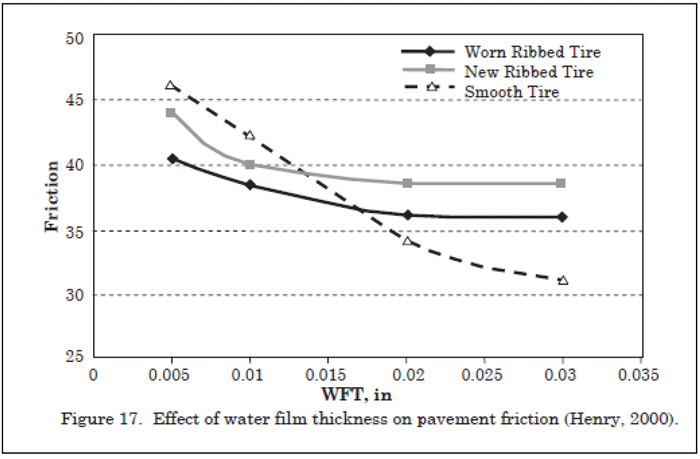
Figure 40. Graph. Figure 17 from NCHRP 108, Guide for Pavement Friction.
A variety of skid resistance surface countermeasures are available. While HFST may have a higher unit cost than traditional friction improvement courses, they can often be applied in small quantities at spot locations for a relatively low project cost. In addition, where cross-section problems exist, such as lack of appropriate superelevation, this approach can be a low cost but effective alternative to address the problem.
HFST is an evolving technology that has demonstrated the ability to dramatically and immediately reduce crashes and related injuries and fatalities. When friction demand exceeds conventional pavement friction capability, high-quality aggregate is applied to existing or potential high-crash areas to help motorists maintain better control in dry and wet driving conditions. HFST uses calcined bauxite aggregate, which has demonstrated the best friction characteristics (microtexture) and polish resistance. Proper gradation needs to be specified to provide proper macrotexture. The binder layer is usually a polymer material. The darker layer of pavement in Figure 41 is an example application of HFST. The National Center for Asphalt Technology's (NCAT) High Friction Surface Treatment Alternative Aggregates Study provides discussion and research results on different aggregate types for HFST.
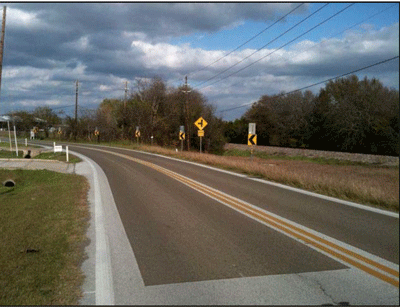
Figure 41. Photo. HFST on a horizontal curve.
HFST can be applied to concrete surfaces or asphalt pavement materials and is available from many manufacturers and contractors. While the aggregate is specialized and generally not produced locally, it is not proprietary. The binder material is usually proprietary but there is ample competition in the industry. Recent innovations in the application method have evolved. HFST have been installed with simple hand tools for many years, but this is slow and a well-trained crew is necessary to attain good quality installations. Some of the installers that work nationally have recently developed equipment for mechanical applications. The equipment varies by the contractor. Some have incorporated more sophisticated equipment for monitoring the quality of the application. Also, application speed varies with the different equipment and aggregate distribution method. The mechanical approach can be more cost effective for large quantity projects, projects with lane closure limitations or multiple small projects. Recent breakthroughs have provided products that are designed to provide quick curing rates even in cold temperatures.
HFST has been tried at a wide variety of countermeasure sites across the country as part of the FHWA's Surface Enhancements at Horizontal Curves (SEAHC) program. Preliminary crash data indicates benefit-cost ratios were as high as 50 to 1. Kentucky alone placed this countermeasure on 30 curves at the beginning of their Roadway Departure Safety Implementation Plan in 2009 and observed a crash reduction of 70 percent to 75 percent at these curves. A Texas Transportation Institute study, Using High Friction Surface Treatments to Improve Safety at Horizontal Curves, compiled crash reductions from other HFST application studies.
HFST is a durable and effective safety countermeasure for roadway departure crashes, especially as a spot application in critical locations. See Appendix G for additional information on the use of HFST in the United States.
This countermeasure is moderate cost.
Pavement grooving is a pavement countermeasure technique to apply longitudinal or transverse cuts onto the pavement surface to increase or restore pavement friction. This is used on concrete pavements and is especially effective in reducing wet-weather crashes by improving the drainage characteristics of the pavement. Potential side effects include increase of vehicular noise (particularly for transverse grooving), possible reduced driver comfort (particularly for longitudinal grooving) and potentially premature wearing of the pavement surface. New grooving techniques have been recently marketed to reduce sound for longitudinal grooving.
New York State DOT evaluated the pavement grooving treatment and found that wet pavement-related crashes were reduced by 55 percent, and the total for both wet and dry pavement crashes were reduced by 23 percent. Various studies cited in the NCHRP Report 500, Volume 7, Strategy 15.2.A8 shows significant crash reductions after applying the pavement grooving countermeasure.
This countermeasure is moderate cost.
Providing superelevation at the curve to help keep vehicles on the road is one of the key geometric design elements that affects crashes on a curve. Superelevation is designed for driver comfort during the acceleration through the curve, and works with friction between the tires and pavement to assist vehicles in maneuvering through curves. Figure 42 provides an illustration of a cross section of a superelevated section. Superelevation is occasionally inadequately designed, lost over time due to settling and/or overlays, or not included as part of the original design consideration due to factors such as traffic volume, constructability, and adjacent land use. As a result, curves with inadequate superelevation may pose a safety problem.
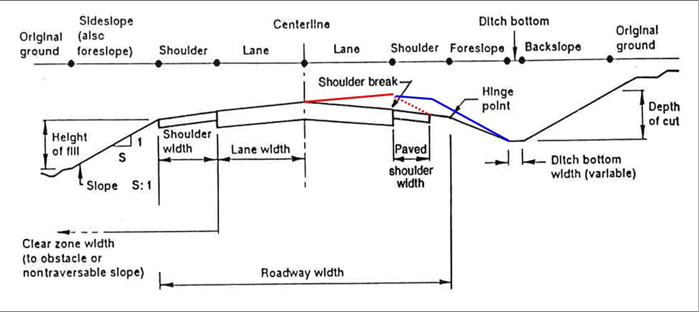
Figure 42. Illustration. A typical cross section of a normal crown with the red and blue lines showing a typical cross section of a superelevated section.
According to the HSM, crash prediction models indicate that inadequate superelevation increases curve crashes. Research results indicate that safety can be enhanced when the superelevation is improved or restored along curves where the actual superelevation is less than the optimal superelevation. However, it should be noted that the increase in driver comfort associated with increasing superelevation may increase speeds.
During routine pavement projects under the pavement preservation program, deficiencies in superelevation should be addressed. Other issues related to superelevation that the designer should pay attention to during routine pavement projects are the slope break between the edge of pavement and the adjacent shoulder. The designer should also have guidance on maximum recommended algebraic differences between the traveled way and the shoulder slopes. Refer to Chapter 3, Section 3.3 of AASHTO's publication "A Policy on Geometric Design of Highways and Streets" (2011) for more details on superelevation design.
When restoring superelevation, special attention is required to maintain proper drainage. A sufficient grade should be maintained along the superelevation transition to provide sufficient drainage where the cross-slope is level or close to level. Care should also be taken to ensure reverse curves have appropriate transition distance.
The HSM provides a function for calculating CMFs for horizontal curves based on superelevation variance (SV), which is provided in Chapter 10 for two-lane rural highways.
This countermeasure is moderate to high cost, depending on extent of correction and scale of project.
The probability of recovering from a run-off-the-road incident is increased if a vehicle is provided with a shoulder, the portion of the roadway outside of the travel lane where a driver can reclaim control of the vehicle. The shoulder is also designed to accommodate stopped vehicles (when sufficiently wide) and to provide side support for the roadside in close proximity to the travel lane. Shoulders can be graded (level surface) or useable (rounding on outside edge). Rounding is simply a gradual change in slope from the usable shoulder to the foreslope.
This area can be further enhanced if the recovery is not impeded by surface irregularities such as potholes, edge drop-offs, or ruts. Such irregularities may make a vehicle more difficult to control. Shoulder countermeasures that promote safe recovery include shoulder widening, shoulder paving, and the installation of the Safety EdgeSM. While each strategy could be covered separately, the effectiveness is related, and the treatments can often be completed as a "package" during roadway resurfacing. These pavement countermeasures within the shoulder area enable the vehicle's recovery to be made in a more controlled fashion and reduce the risk of overturning or crossing into the opposing lane.
Shoulders are a safety feature because they provide space that allows drivers to get out of the travel lane and avoid crashes. This feature is particularly important in horizontal curves where vehicles typically use more of the travel lane than in straight sections. By widening the shoulders or providing a shoulder where one previously did not exist, drivers have more recovery area to regain control in the event of a roadway departure.
Shoulder widths can vary from approximately no shoulder on minor rural roads to 12 feet on major roads where the entire shoulder may be stabilized or paved. Agencies should stabilize widened shoulders and minimize steepening of roadside slopes. As Figures 43 illustrates, agencies can widen shoulders on both the inside and outside. If space is only available to one side, widening the outside shoulder will most likely provide the greater benefit.
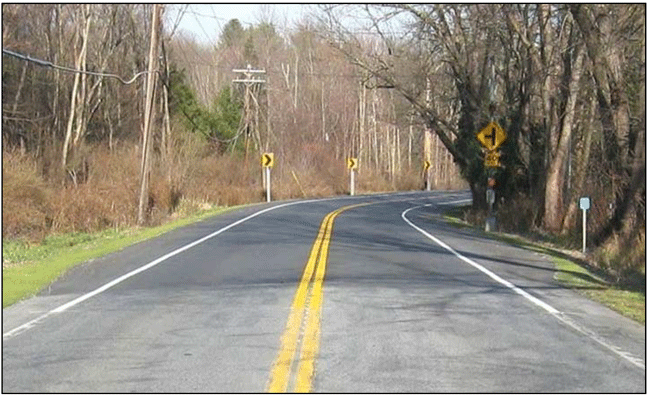
Figure 43. Photo. Widening on the inside and outside of the curve.
Table 6 shows the percent change in crashes (including single vehicle run-off-road and multiple vehicle head-on and sideswipe crashes) in comparison to a road with 6-foot shoulders. The table suggests that roads with shoulder widths less than 6 feet will have more crashes than a road with 6-foot shoulders. Conversely, roads with shoulder widths 8 feet or more will have fewer crashes than a road with 6-foot shoulders. Although the table was developed for rural two-lane roads, and is not limited to horizontal curves, it is reasonable to expect the maximum benefit from shoulder widening can also be realized for horizontal curves.
Table 6. Percent change in crashes relative to providing a 6-foot shoulder on rural two-lane roadway segments (Modified from HSM Table13-7).
| Shoulder Width | Percent change in crashes in comparison to roads with 6-foot shoulders | ||
|---|---|---|---|
| Average Annual Daily Traffic (AADT) (vehicles/day) | |||
| <400 | 400-2,000 | >2,000 | |
| 0 ft | + 10% | Between +10% and +50%, depending on AADT | + 50% |
| 2 ft | + 7% | Between +7% and +30%, depending on AADT | + 30% |
| 4 ft | + 2% | Between +2% and +15%, depending on AADT | + 15% |
| 6 ft | 0% | 0% | 0% |
| 8 ft or more | - 2% | Between -2% and -13%, depending on AADT | – 13% |
* Crash types: Single vehicle run-off-road, multiple vehicle head-on, opposite direction sideswipe, and same-direction sideswipe.
This countermeasure is high cost.
When right-of-way permits, replacing unstable or narrow shoulders with paved shoulders increases the total usable width of the roadway. This improves safety for all road users (motorized and non-motorized). With this extra paved roadway, vehicles have an increased capacity for recovery if they leave the travel lanes. Paving shoulders can also be accompanied by Safety EdgeSM and rumble strips. Figure 44 shows an example of a shoulder paving operation.
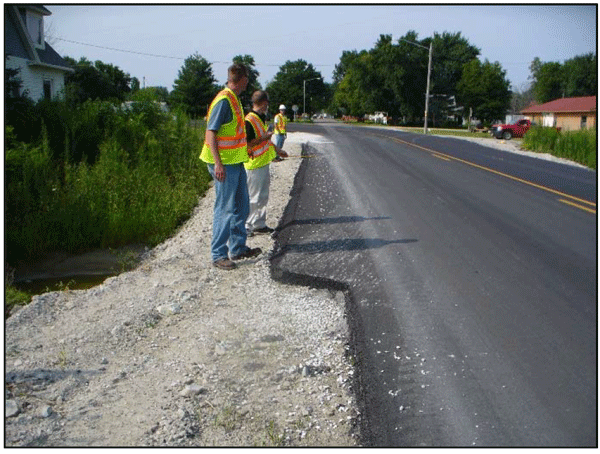
Figure 44. Photo. Shoulder paving operation.
While limited budgets may influence an agency's decision to upgrade to paved shoulders on two-lane tangent sections, the resulting benefit-cost ratio from fewer crashes on curves with paved shoulders deserves consideration. In some cases, widening shoulders may be more desirable than widening lanes.
The CMF Clearinghouse lists only one CMF for paving the shoulder through a curve. It indicates an increase in crashes (CMF is 1 star) (Pitale et al., 2009). Other research results for paving shoulders (not exclusively within curves) indicate that paving shoulders reduces crashes.
This countermeasure is high cost.
Safety EdgeSM is a paving technique used system-wide to improve pavement durability and reduce crashes by shaping and consolidating the pavement edge into a 30-degree wedge, as demonstrated in Figure 45. The shape of the edge allows controlled recovery for drivers returning to the pavement after straying due to inattention. The added durability of the edge reduces the tendency of the pavement to ravel, providing a consistent pavement width. It should be noted that the recommended practice is to bring the adjacent shoulder material or roadside vegetation up even with the pavement surface, thereby covering the Safety EdgeSM after the paving is complete (Figure 46). The shape of the Safety EdgeSM is exposed at various times over the life of the pavement, as this material settles or is dislodged by traffic.
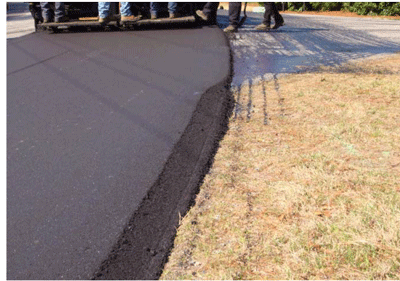
Figure 45. Photo. Pavement with and without the Safety EdgeSM.
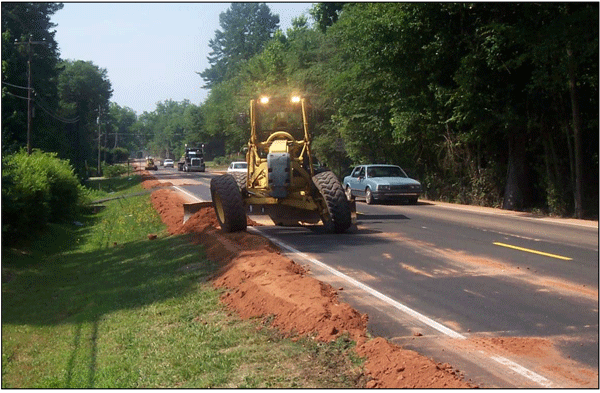
Figure 46. Photo. Backfilling against newly installed Safety EdgeSM.
The Safety EdgeSM is formed while paving and therefore, is not appropriate as a spot countermeasure for curves. However, this countermeasure is particularly helpful at curves where the roadway departure crashes it addresses are prevalent. It is the ultimate systemic countermeasure, which when applied on every paving project, will provide added safety wherever a driver leaves the pavement. The cost is a very minor addition to the cost of the paving process under which it is applied.
Most State DOTs now use Safety EdgeSM as a standard practice and therefore have appropriate specifications and drawings for use in contract documents. Additional information is available in FHWA's Safety EdgeSM Design and Construction Guide.
Safety EdgeSM has been proven for many years based on physical tests with vehicles. In addition, a recent study showed it could reduce total crashes by approximately 6 percent on two-lane roads (CMF is 4 stars) (Graham et al., 2011). The FHWA Office of Safety is sponsoring a project to estimate an updated CMF for the Safety EdgeSM paving technique on two-lane rural highways. Results from this evaluation are anticipated in December 2016.
This countermeasure is very low cost.
Longitudinal rumble strips are milled or raised elements on the pavement intended to alert inattentive drivers through vibration and sound that their vehicles have left the travel lane. There are a number of possible applications that can be used:
Because rumble strips apply to a human behavior problem rather than a roadway deficiency, they are best applied as a systemic countermeasure. Driver inattentiveness or drowsiness cannot be predicted by location; however, the type of system where application will be most effective can often be predicted from previous crash experience, using factors such as ADT or roadway classification.
Milled rumble strips have been shown to be more effective than other types of rumble strips at creating noise loud enough to alert inattentive and fatigued drivers (NCHRP Report 641, 2009). Milled rumble strips can also be installed at any time on new or existing pavements. In regions where plowing is not an issue, various types of raised rumble strips may be used as an alternative. Figure 47 shows a milled centerline rumble stripe, and Figure 48 shows a milled edge line rumble stripe.
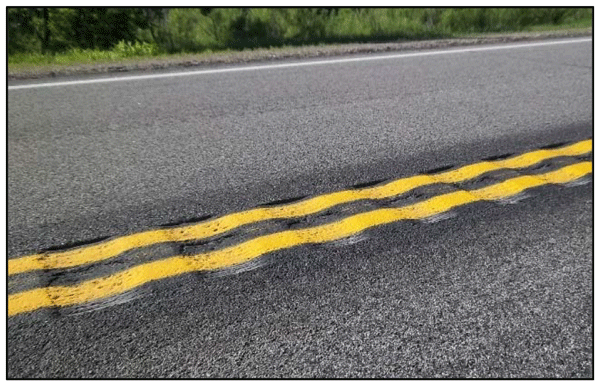
Figure 47. Photo. Milled Center Line Rumble Stripes.
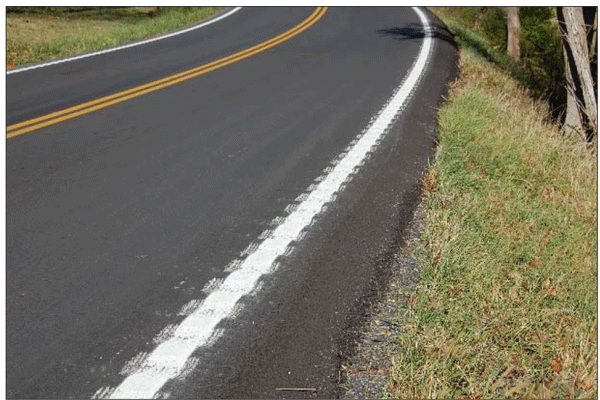
Figure 48. Photo. Milled Edge Line Rumble Stripes. Source: KYTC.
For more information on rumble strip design and installation, see FHWA technical advisories at:The CMF Clearinghouse contains a large number of CMFs for installing rumble strips on various types of roads and conditions. NCHRP Report 641 indicates that installing shoulder rumble strips on two-lane rural roads result in a 15-percent to 29-percent reduction in crashes, depending on the crash type (CMF is 5 stars). The same report also indicates that installing center line rumble strips on two-lane rural roads result in a 9-percent to 44-percent reduction in crashes, depending on the crash type (CMF is 5 stars). Studies have shown that the crash reductions for center line rumble strips in curves and tangents are approximately the same.
This countermeasure is low cost.
| < Previous | Table of Contents | Next > |
